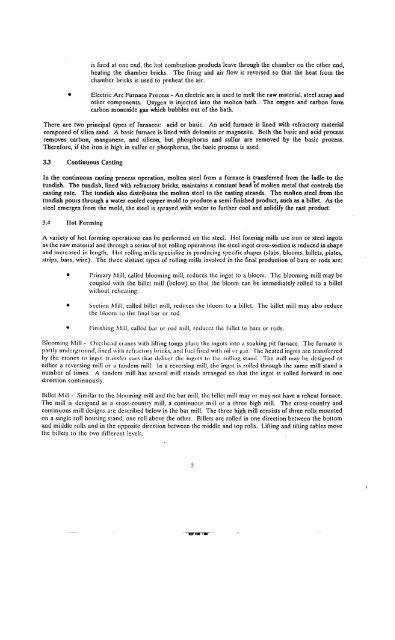Watcr Q!!alit\1 lmprovcmct1t at1() COf1scrvatiof1l'rojcct
Watcr Q!!alit\1 lmprovcmct1t at1() COf1scrvatiof1l'rojcct
Watcr Q!!alit\1 lmprovcmct1t at1() COf1scrvatiof1l'rojcct
You also want an ePaper? Increase the reach of your titles
YUMPU automatically turns print PDFs into web optimized ePapers that Google loves.
is fired at one end, the hot combustion products leave through the chamber on the other end,<br />
heating the chamber bricks. The firing and air flow is reversed so that the heat from the<br />
chamber bricks is U!:ed to preheat the air.<br />
• Electric Arc Furnace Process - An electric arc is used to melt the raw material, steel scrap and<br />
other componenLo:. Oxygcn is injected into the molten bath. The oxygen and carbon form<br />
carbon monoxide gas which bubbles out of the bath.<br />
There are two principal types of furnaces: acid or basic. An acid furnace is lined with refractory material<br />
composed of silica sand. A basic furnace is lined with dolomite or magnesite. Both the basic and acid process<br />
removes carbon, manganese, and silicon, but phosphorus and sulfur are removed by the basic process.<br />
Therefore, if the iron is high in sulfur or phosphorus, the basie proces..o: is used.<br />
3.3 Continuous Casting<br />
In the continuous casting process operation, molten steel from a furnace is transferred from the ladle to the<br />
tundish. The tundish, lined with refractory bricks, maintains a constant head of molten metal that coDtrols the<br />
casting rate. The tundisb also distributes the molteD steel to the casting strands. The molteD steel from the<br />
tUDdisb pours through a water cooled copper mold to produce a semi-fmished product, such as a billet. As the<br />
steel emerges from the mold, the steel is sprayed with water to further cool and solidify the cast product.<br />
3.4 lIot Forming<br />
A variety of hot forming operations can be performed on the steel. Hot forming mills use iron or steel ingots<br />
as the raw material and through a serie.o: of hot rolling operations the steel ingot cross-section is reduced in shape<br />
and incrcased in length. flot rolling mills speeiali7.c in producing specific shape.o: (slabs, blooms, billets, plates,<br />
strips, bars, ....ire). The three distinct types of rolling mills involved in the final production of bars or rods are:<br />
• Primary Mill, Cdlled blooming mill, reduccs the ingot to a bloom. The blooming mill may be<br />
coupled with the billet mill (below) so that the bloom can be immediately rolled to a billet<br />
without reheating.<br />
• Section Mill, called billet mill, reduces thc bloom to a billet. The billct mill may also reduce<br />
thc bloom tu thc final bar or rod.<br />
• Pinishing l\fill, called bar or rod mill, reduces the billet to bars or rods.<br />
Blooming Mill - Overhead cranes with lifting tongs place the ingots into a soaking pit furnace. The furnace is<br />
partly undcrground, lined with refractory bricks, and flld fired with oil (lr gas. The heated ingots are transferred<br />
by the crancs 10 ingot transfcr cars that delivcr (hc ingot.

















